Health Information Technology Report for HA565 - Unit 9 Assignment
VerifiedAdded on 2022/11/16
|11
|3260
|141
Report
AI Summary
This report provides a comprehensive overview of Health Information Technology (HIT) and its significance in healthcare. It begins by defining HIT and its various applications, including electronic health records (EHRs) and telemedicine, highlighting its importance in improving healthcare delivery, patient safety, and communication. The report then delves into the ways individuals, professionals, and organizations utilize HIT, emphasizing the benefits of systems like OpenMRS and Health Information Exchange (HIE). It explores how HIT enhances the provision of quality care by reducing medical errors, streamlining workflows, and improving clinical decision-making. Furthermore, the report discusses the future of HIT, including the role of big data and advanced technologies, and concludes by emphasizing the critical role HIT will play in addressing the complexities of healthcare in the coming years.
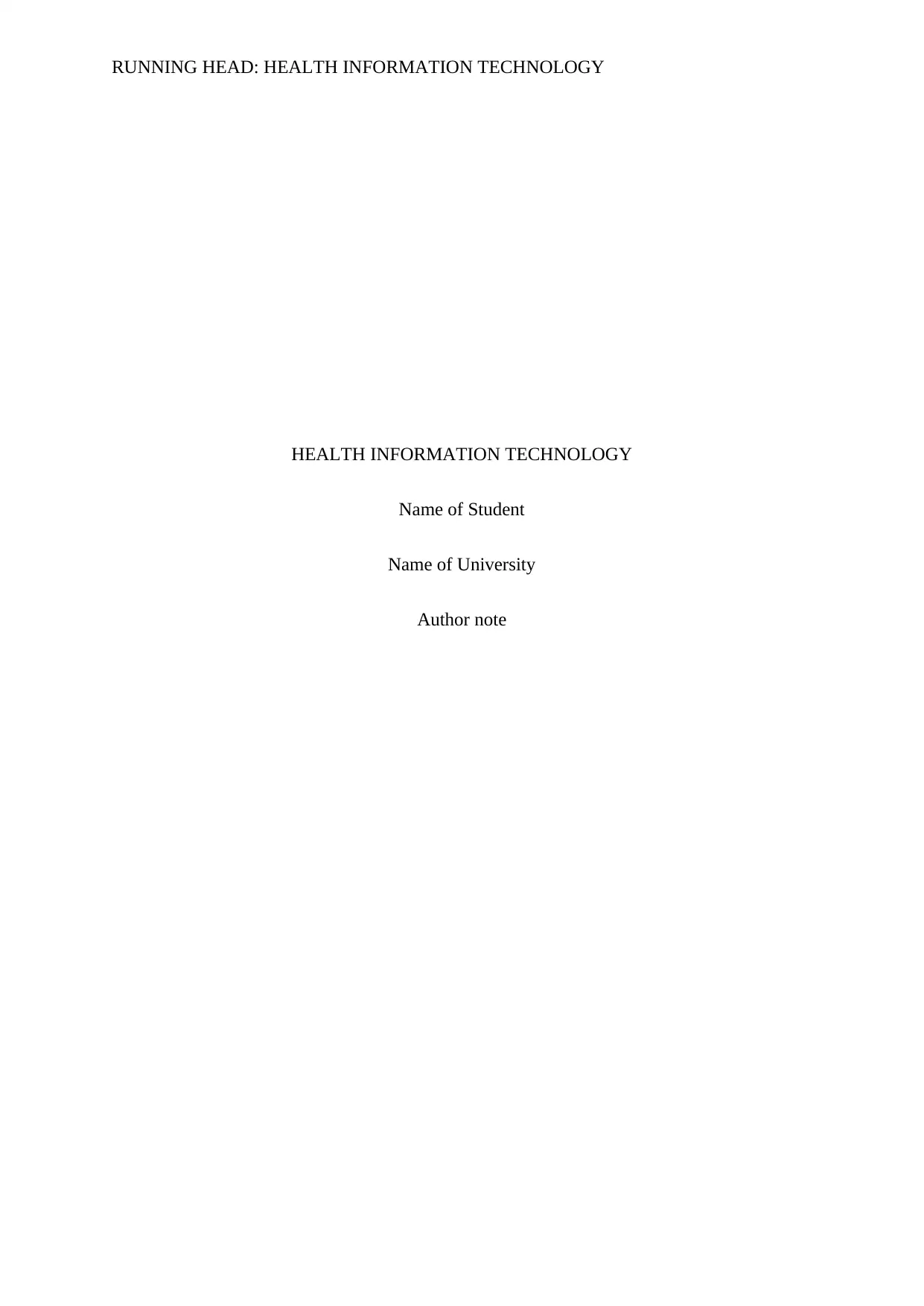
RUNNING HEAD: HEALTH INFORMATION TECHNOLOGY
HEALTH INFORMATION TECHNOLOGY
Name of Student
Name of University
Author note
HEALTH INFORMATION TECHNOLOGY
Name of Student
Name of University
Author note
Paraphrase This Document
Need a fresh take? Get an instant paraphrase of this document with our AI Paraphraser
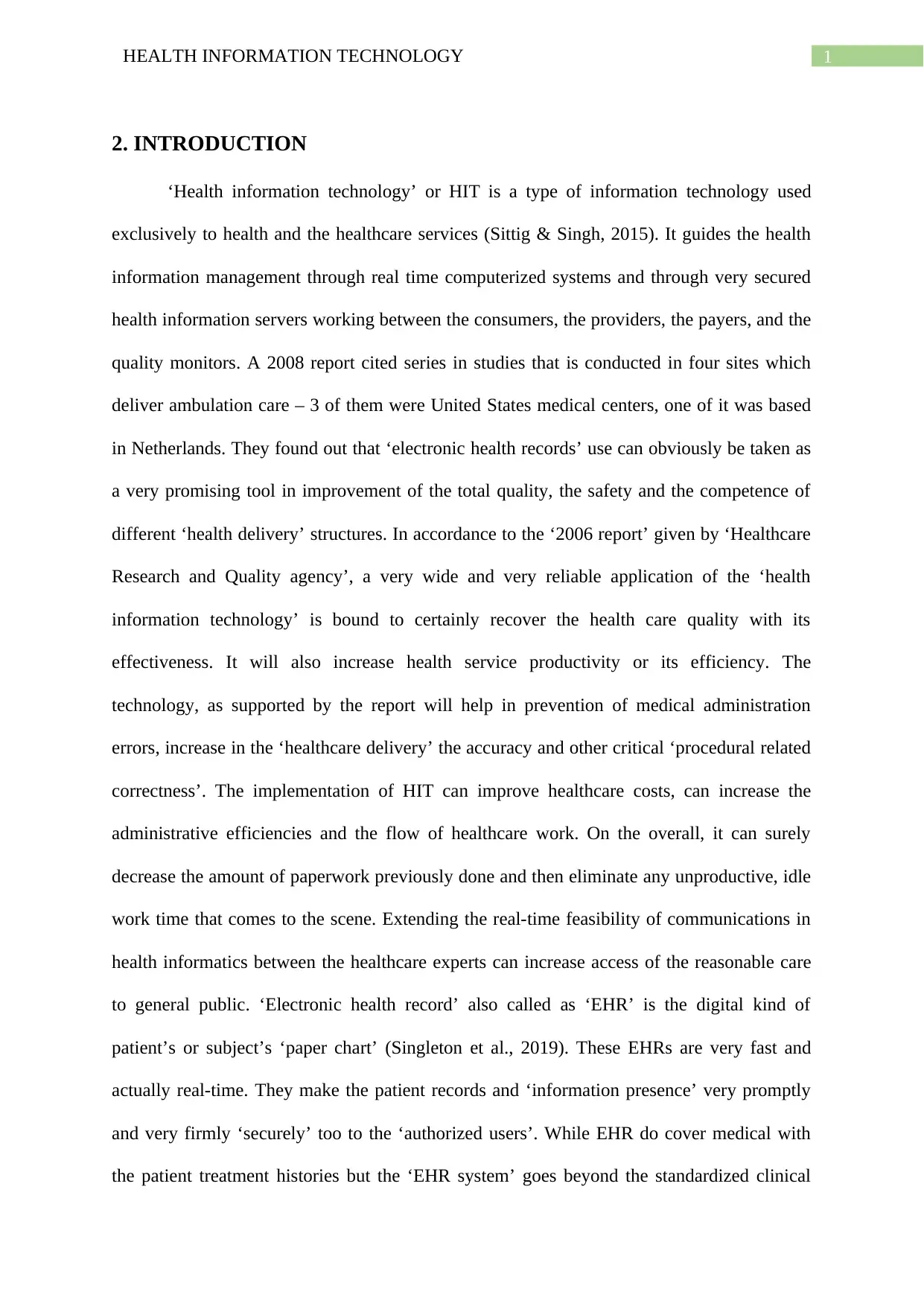
1HEALTH INFORMATION TECHNOLOGY
2. INTRODUCTION
‘Health information technology’ or HIT is a type of information technology used
exclusively to health and the healthcare services (Sittig & Singh, 2015). It guides the health
information management through real time computerized systems and through very secured
health information servers working between the consumers, the providers, the payers, and the
quality monitors. A 2008 report cited series in studies that is conducted in four sites which
deliver ambulation care – 3 of them were United States medical centers, one of it was based
in Netherlands. They found out that ‘electronic health records’ use can obviously be taken as
a very promising tool in improvement of the total quality, the safety and the competence of
different ‘health delivery’ structures. In accordance to the ‘2006 report’ given by ‘Healthcare
Research and Quality agency’, a very wide and very reliable application of the ‘health
information technology’ is bound to certainly recover the health care quality with its
effectiveness. It will also increase health service productivity or its efficiency. The
technology, as supported by the report will help in prevention of medical administration
errors, increase in the ‘healthcare delivery’ the accuracy and other critical ‘procedural related
correctness’. The implementation of HIT can improve healthcare costs, can increase the
administrative efficiencies and the flow of healthcare work. On the overall, it can surely
decrease the amount of paperwork previously done and then eliminate any unproductive, idle
work time that comes to the scene. Extending the real-time feasibility of communications in
health informatics between the healthcare experts can increase access of the reasonable care
to general public. ‘Electronic health record’ also called as ‘EHR’ is the digital kind of
patient’s or subject’s ‘paper chart’ (Singleton et al., 2019). These EHRs are very fast and
actually real-time. They make the patient records and ‘information presence’ very promptly
and very firmly ‘securely’ too to the ‘authorized users’. While EHR do cover medical with
the patient treatment histories but the ‘EHR system’ goes beyond the standardized clinical
2. INTRODUCTION
‘Health information technology’ or HIT is a type of information technology used
exclusively to health and the healthcare services (Sittig & Singh, 2015). It guides the health
information management through real time computerized systems and through very secured
health information servers working between the consumers, the providers, the payers, and the
quality monitors. A 2008 report cited series in studies that is conducted in four sites which
deliver ambulation care – 3 of them were United States medical centers, one of it was based
in Netherlands. They found out that ‘electronic health records’ use can obviously be taken as
a very promising tool in improvement of the total quality, the safety and the competence of
different ‘health delivery’ structures. In accordance to the ‘2006 report’ given by ‘Healthcare
Research and Quality agency’, a very wide and very reliable application of the ‘health
information technology’ is bound to certainly recover the health care quality with its
effectiveness. It will also increase health service productivity or its efficiency. The
technology, as supported by the report will help in prevention of medical administration
errors, increase in the ‘healthcare delivery’ the accuracy and other critical ‘procedural related
correctness’. The implementation of HIT can improve healthcare costs, can increase the
administrative efficiencies and the flow of healthcare work. On the overall, it can surely
decrease the amount of paperwork previously done and then eliminate any unproductive, idle
work time that comes to the scene. Extending the real-time feasibility of communications in
health informatics between the healthcare experts can increase access of the reasonable care
to general public. ‘Electronic health record’ also called as ‘EHR’ is the digital kind of
patient’s or subject’s ‘paper chart’ (Singleton et al., 2019). These EHRs are very fast and
actually real-time. They make the patient records and ‘information presence’ very promptly
and very firmly ‘securely’ too to the ‘authorized users’. While EHR do cover medical with
the patient treatment histories but the ‘EHR system’ goes beyond the standardized clinical
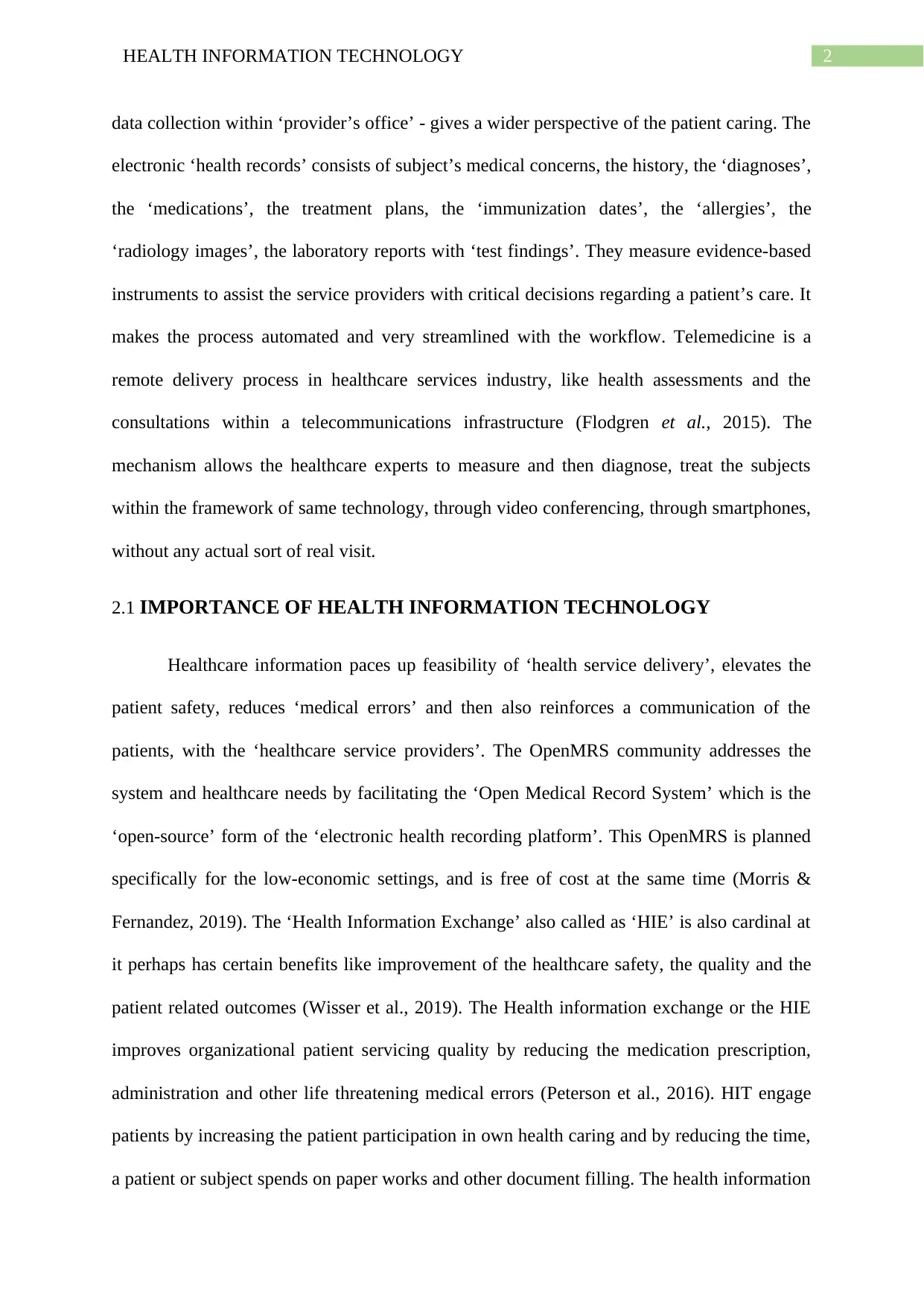
2HEALTH INFORMATION TECHNOLOGY
data collection within ‘provider’s office’ - gives a wider perspective of the patient caring. The
electronic ‘health records’ consists of subject’s medical concerns, the history, the ‘diagnoses’,
the ‘medications’, the treatment plans, the ‘immunization dates’, the ‘allergies’, the
‘radiology images’, the laboratory reports with ‘test findings’. They measure evidence-based
instruments to assist the service providers with critical decisions regarding a patient’s care. It
makes the process automated and very streamlined with the workflow. Telemedicine is a
remote delivery process in healthcare services industry, like health assessments and the
consultations within a telecommunications infrastructure (Flodgren et al., 2015). The
mechanism allows the healthcare experts to measure and then diagnose, treat the subjects
within the framework of same technology, through video conferencing, through smartphones,
without any actual sort of real visit.
2.1 IMPORTANCE OF HEALTH INFORMATION TECHNOLOGY
Healthcare information paces up feasibility of ‘health service delivery’, elevates the
patient safety, reduces ‘medical errors’ and then also reinforces a communication of the
patients, with the ‘healthcare service providers’. The OpenMRS community addresses the
system and healthcare needs by facilitating the ‘Open Medical Record System’ which is the
‘open-source’ form of the ‘electronic health recording platform’. This OpenMRS is planned
specifically for the low-economic settings, and is free of cost at the same time (Morris &
Fernandez, 2019). The ‘Health Information Exchange’ also called as ‘HIE’ is also cardinal at
it perhaps has certain benefits like improvement of the healthcare safety, the quality and the
patient related outcomes (Wisser et al., 2019). The Health information exchange or the HIE
improves organizational patient servicing quality by reducing the medication prescription,
administration and other life threatening medical errors (Peterson et al., 2016). HIT engage
patients by increasing the patient participation in own health caring and by reducing the time,
a patient or subject spends on paper works and other document filling. The health information
data collection within ‘provider’s office’ - gives a wider perspective of the patient caring. The
electronic ‘health records’ consists of subject’s medical concerns, the history, the ‘diagnoses’,
the ‘medications’, the treatment plans, the ‘immunization dates’, the ‘allergies’, the
‘radiology images’, the laboratory reports with ‘test findings’. They measure evidence-based
instruments to assist the service providers with critical decisions regarding a patient’s care. It
makes the process automated and very streamlined with the workflow. Telemedicine is a
remote delivery process in healthcare services industry, like health assessments and the
consultations within a telecommunications infrastructure (Flodgren et al., 2015). The
mechanism allows the healthcare experts to measure and then diagnose, treat the subjects
within the framework of same technology, through video conferencing, through smartphones,
without any actual sort of real visit.
2.1 IMPORTANCE OF HEALTH INFORMATION TECHNOLOGY
Healthcare information paces up feasibility of ‘health service delivery’, elevates the
patient safety, reduces ‘medical errors’ and then also reinforces a communication of the
patients, with the ‘healthcare service providers’. The OpenMRS community addresses the
system and healthcare needs by facilitating the ‘Open Medical Record System’ which is the
‘open-source’ form of the ‘electronic health recording platform’. This OpenMRS is planned
specifically for the low-economic settings, and is free of cost at the same time (Morris &
Fernandez, 2019). The ‘Health Information Exchange’ also called as ‘HIE’ is also cardinal at
it perhaps has certain benefits like improvement of the healthcare safety, the quality and the
patient related outcomes (Wisser et al., 2019). The Health information exchange or the HIE
improves organizational patient servicing quality by reducing the medication prescription,
administration and other life threatening medical errors (Peterson et al., 2016). HIT engage
patients by increasing the patient participation in own health caring and by reducing the time,
a patient or subject spends on paper works and other document filling. The health information
⊘ This is a preview!⊘
Do you want full access?
Subscribe today to unlock all pages.

Trusted by 1+ million students worldwide
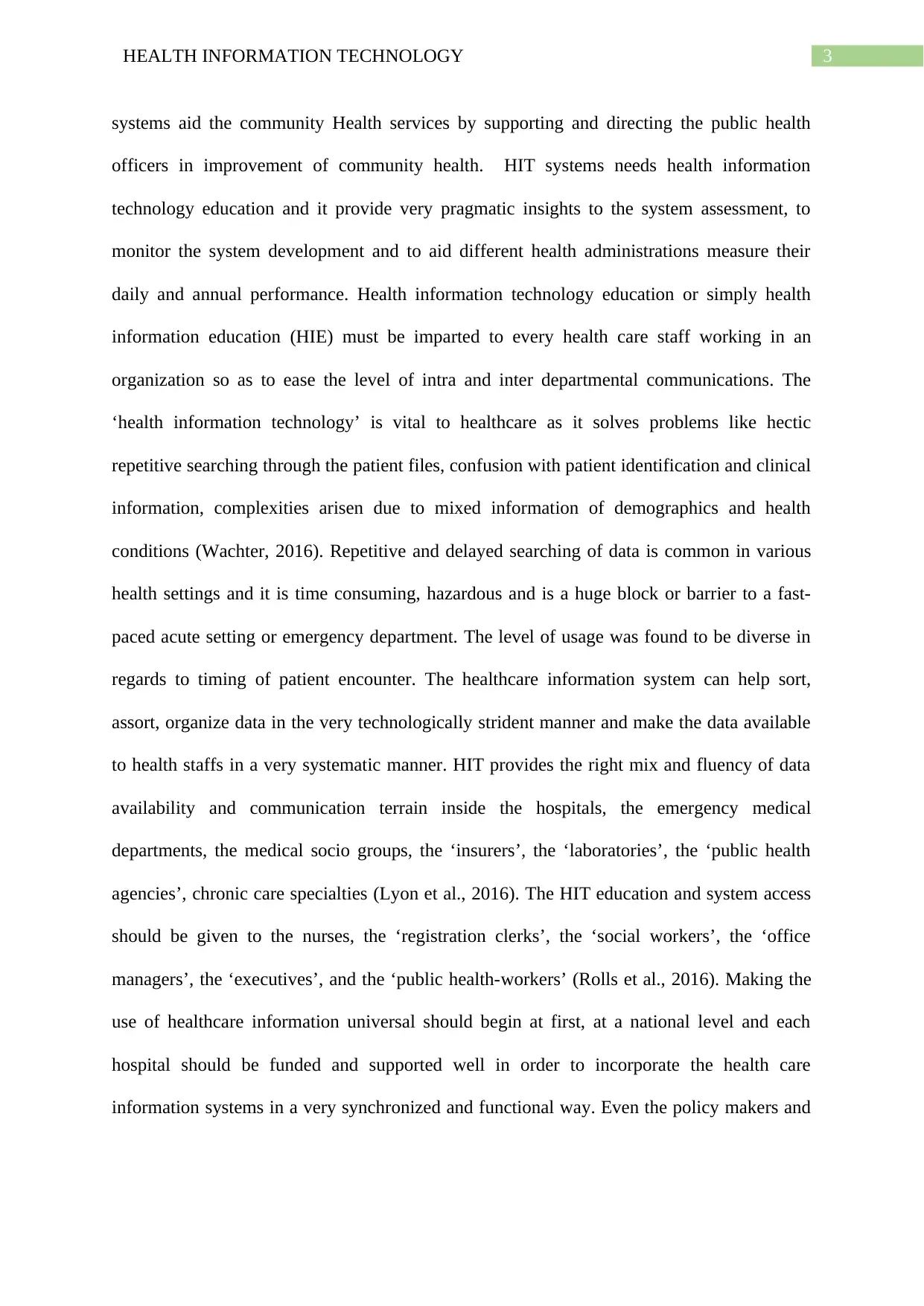
3HEALTH INFORMATION TECHNOLOGY
systems aid the community Health services by supporting and directing the public health
officers in improvement of community health. HIT systems needs health information
technology education and it provide very pragmatic insights to the system assessment, to
monitor the system development and to aid different health administrations measure their
daily and annual performance. Health information technology education or simply health
information education (HIE) must be imparted to every health care staff working in an
organization so as to ease the level of intra and inter departmental communications. The
‘health information technology’ is vital to healthcare as it solves problems like hectic
repetitive searching through the patient files, confusion with patient identification and clinical
information, complexities arisen due to mixed information of demographics and health
conditions (Wachter, 2016). Repetitive and delayed searching of data is common in various
health settings and it is time consuming, hazardous and is a huge block or barrier to a fast-
paced acute setting or emergency department. The level of usage was found to be diverse in
regards to timing of patient encounter. The healthcare information system can help sort,
assort, organize data in the very technologically strident manner and make the data available
to health staffs in a very systematic manner. HIT provides the right mix and fluency of data
availability and communication terrain inside the hospitals, the emergency medical
departments, the medical socio groups, the ‘insurers’, the ‘laboratories’, the ‘public health
agencies’, chronic care specialties (Lyon et al., 2016). The HIT education and system access
should be given to the nurses, the ‘registration clerks’, the ‘social workers’, the ‘office
managers’, the ‘executives’, and the ‘public health-workers’ (Rolls et al., 2016). Making the
use of healthcare information universal should begin at first, at a national level and each
hospital should be funded and supported well in order to incorporate the health care
information systems in a very synchronized and functional way. Even the policy makers and
systems aid the community Health services by supporting and directing the public health
officers in improvement of community health. HIT systems needs health information
technology education and it provide very pragmatic insights to the system assessment, to
monitor the system development and to aid different health administrations measure their
daily and annual performance. Health information technology education or simply health
information education (HIE) must be imparted to every health care staff working in an
organization so as to ease the level of intra and inter departmental communications. The
‘health information technology’ is vital to healthcare as it solves problems like hectic
repetitive searching through the patient files, confusion with patient identification and clinical
information, complexities arisen due to mixed information of demographics and health
conditions (Wachter, 2016). Repetitive and delayed searching of data is common in various
health settings and it is time consuming, hazardous and is a huge block or barrier to a fast-
paced acute setting or emergency department. The level of usage was found to be diverse in
regards to timing of patient encounter. The healthcare information system can help sort,
assort, organize data in the very technologically strident manner and make the data available
to health staffs in a very systematic manner. HIT provides the right mix and fluency of data
availability and communication terrain inside the hospitals, the emergency medical
departments, the medical socio groups, the ‘insurers’, the ‘laboratories’, the ‘public health
agencies’, chronic care specialties (Lyon et al., 2016). The HIT education and system access
should be given to the nurses, the ‘registration clerks’, the ‘social workers’, the ‘office
managers’, the ‘executives’, and the ‘public health-workers’ (Rolls et al., 2016). Making the
use of healthcare information universal should begin at first, at a national level and each
hospital should be funded and supported well in order to incorporate the health care
information systems in a very synchronized and functional way. Even the policy makers and
Paraphrase This Document
Need a fresh take? Get an instant paraphrase of this document with our AI Paraphraser
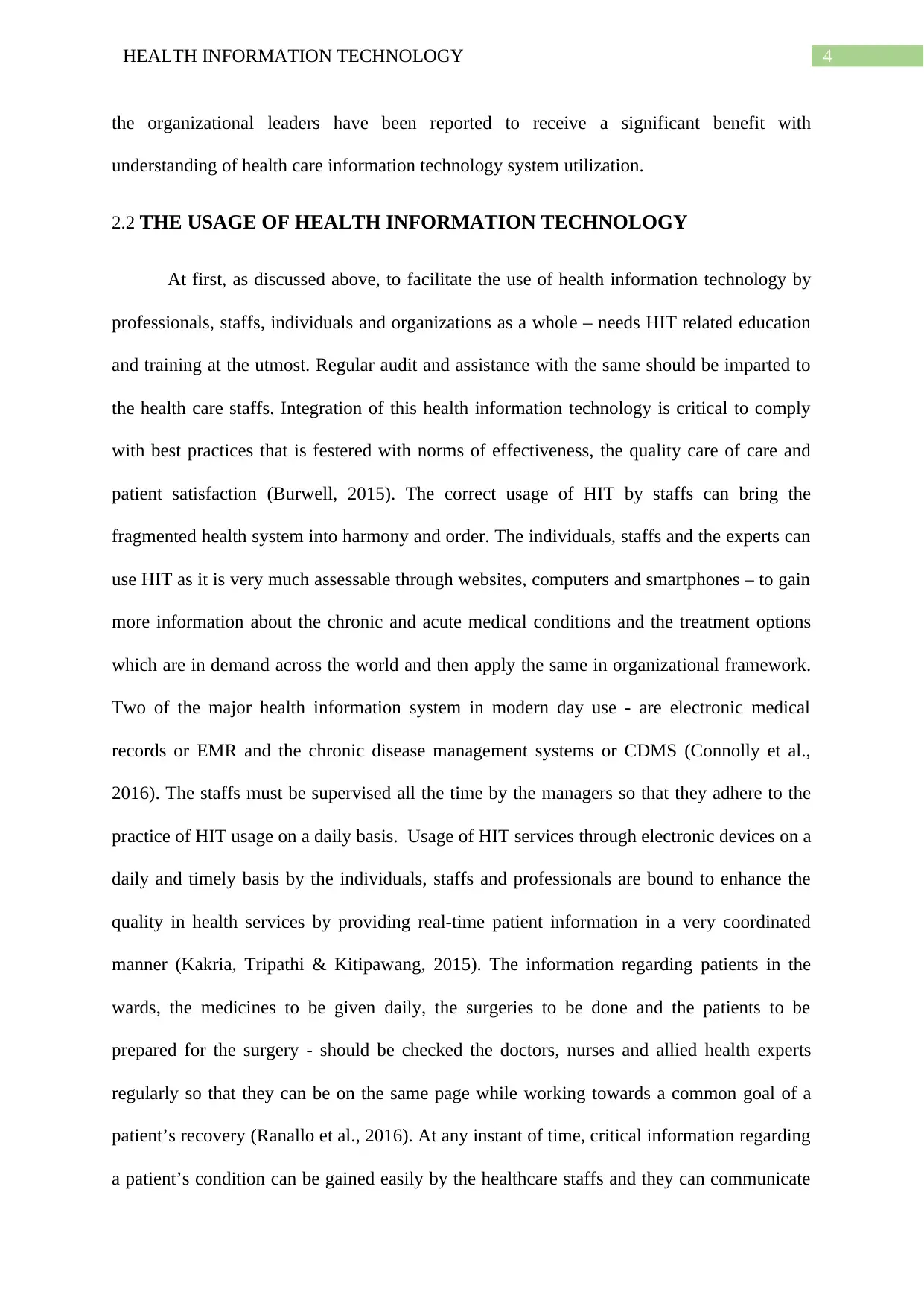
4HEALTH INFORMATION TECHNOLOGY
the organizational leaders have been reported to receive a significant benefit with
understanding of health care information technology system utilization.
2.2 THE USAGE OF HEALTH INFORMATION TECHNOLOGY
At first, as discussed above, to facilitate the use of health information technology by
professionals, staffs, individuals and organizations as a whole – needs HIT related education
and training at the utmost. Regular audit and assistance with the same should be imparted to
the health care staffs. Integration of this health information technology is critical to comply
with best practices that is festered with norms of effectiveness, the quality care of care and
patient satisfaction (Burwell, 2015). The correct usage of HIT by staffs can bring the
fragmented health system into harmony and order. The individuals, staffs and the experts can
use HIT as it is very much assessable through websites, computers and smartphones – to gain
more information about the chronic and acute medical conditions and the treatment options
which are in demand across the world and then apply the same in organizational framework.
Two of the major health information system in modern day use - are electronic medical
records or EMR and the chronic disease management systems or CDMS (Connolly et al.,
2016). The staffs must be supervised all the time by the managers so that they adhere to the
practice of HIT usage on a daily basis. Usage of HIT services through electronic devices on a
daily and timely basis by the individuals, staffs and professionals are bound to enhance the
quality in health services by providing real-time patient information in a very coordinated
manner (Kakria, Tripathi & Kitipawang, 2015). The information regarding patients in the
wards, the medicines to be given daily, the surgeries to be done and the patients to be
prepared for the surgery - should be checked the doctors, nurses and allied health experts
regularly so that they can be on the same page while working towards a common goal of a
patient’s recovery (Ranallo et al., 2016). At any instant of time, critical information regarding
a patient’s condition can be gained easily by the healthcare staffs and they can communicate
the organizational leaders have been reported to receive a significant benefit with
understanding of health care information technology system utilization.
2.2 THE USAGE OF HEALTH INFORMATION TECHNOLOGY
At first, as discussed above, to facilitate the use of health information technology by
professionals, staffs, individuals and organizations as a whole – needs HIT related education
and training at the utmost. Regular audit and assistance with the same should be imparted to
the health care staffs. Integration of this health information technology is critical to comply
with best practices that is festered with norms of effectiveness, the quality care of care and
patient satisfaction (Burwell, 2015). The correct usage of HIT by staffs can bring the
fragmented health system into harmony and order. The individuals, staffs and the experts can
use HIT as it is very much assessable through websites, computers and smartphones – to gain
more information about the chronic and acute medical conditions and the treatment options
which are in demand across the world and then apply the same in organizational framework.
Two of the major health information system in modern day use - are electronic medical
records or EMR and the chronic disease management systems or CDMS (Connolly et al.,
2016). The staffs must be supervised all the time by the managers so that they adhere to the
practice of HIT usage on a daily basis. Usage of HIT services through electronic devices on a
daily and timely basis by the individuals, staffs and professionals are bound to enhance the
quality in health services by providing real-time patient information in a very coordinated
manner (Kakria, Tripathi & Kitipawang, 2015). The information regarding patients in the
wards, the medicines to be given daily, the surgeries to be done and the patients to be
prepared for the surgery - should be checked the doctors, nurses and allied health experts
regularly so that they can be on the same page while working towards a common goal of a
patient’s recovery (Ranallo et al., 2016). At any instant of time, critical information regarding
a patient’s condition can be gained easily by the healthcare staffs and they can communicate
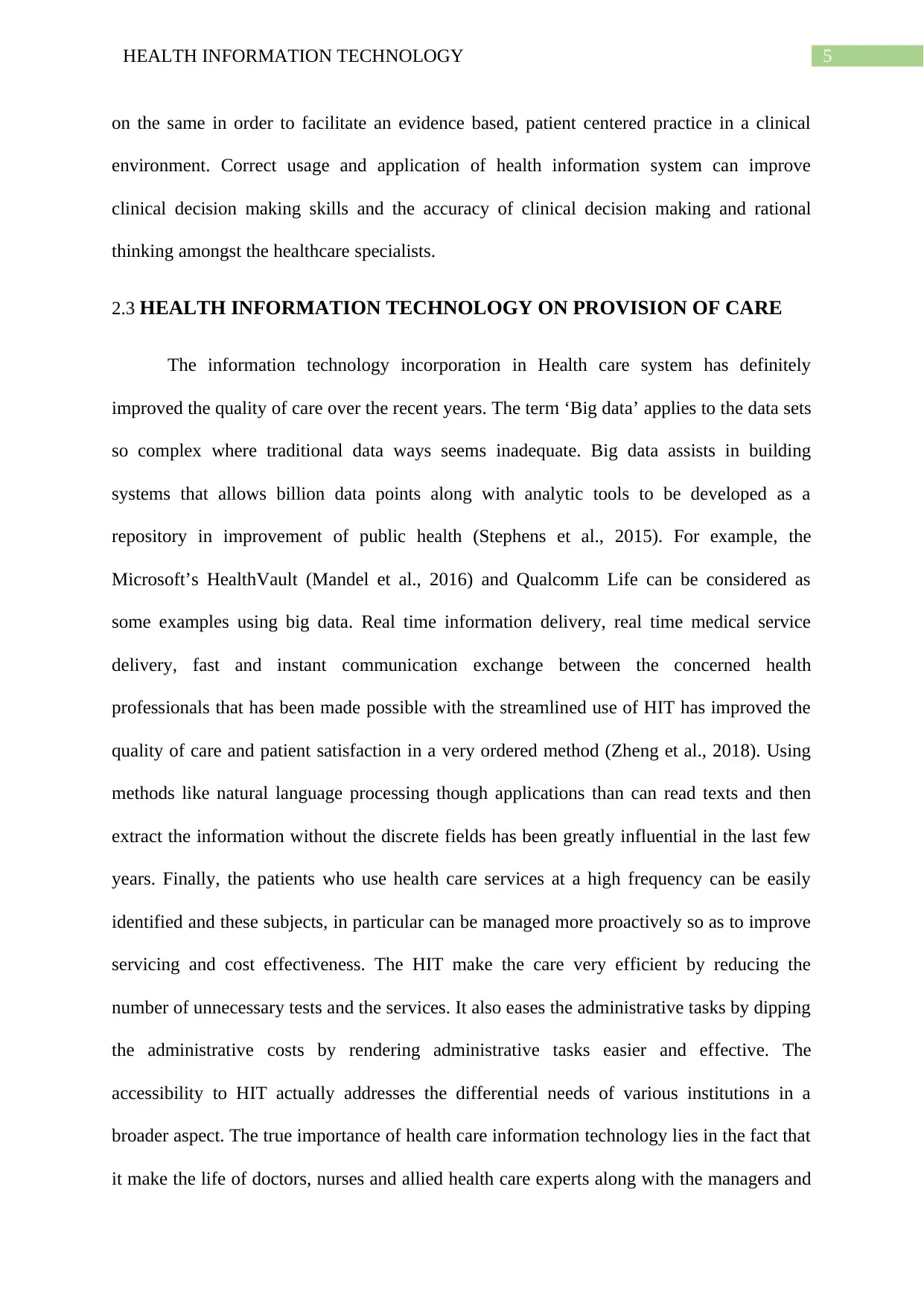
5HEALTH INFORMATION TECHNOLOGY
on the same in order to facilitate an evidence based, patient centered practice in a clinical
environment. Correct usage and application of health information system can improve
clinical decision making skills and the accuracy of clinical decision making and rational
thinking amongst the healthcare specialists.
2.3 HEALTH INFORMATION TECHNOLOGY ON PROVISION OF CARE
The information technology incorporation in Health care system has definitely
improved the quality of care over the recent years. The term ‘Big data’ applies to the data sets
so complex where traditional data ways seems inadequate. Big data assists in building
systems that allows billion data points along with analytic tools to be developed as a
repository in improvement of public health (Stephens et al., 2015). For example, the
Microsoft’s HealthVault (Mandel et al., 2016) and Qualcomm Life can be considered as
some examples using big data. Real time information delivery, real time medical service
delivery, fast and instant communication exchange between the concerned health
professionals that has been made possible with the streamlined use of HIT has improved the
quality of care and patient satisfaction in a very ordered method (Zheng et al., 2018). Using
methods like natural language processing though applications than can read texts and then
extract the information without the discrete fields has been greatly influential in the last few
years. Finally, the patients who use health care services at a high frequency can be easily
identified and these subjects, in particular can be managed more proactively so as to improve
servicing and cost effectiveness. The HIT make the care very efficient by reducing the
number of unnecessary tests and the services. It also eases the administrative tasks by dipping
the administrative costs by rendering administrative tasks easier and effective. The
accessibility to HIT actually addresses the differential needs of various institutions in a
broader aspect. The true importance of health care information technology lies in the fact that
it make the life of doctors, nurses and allied health care experts along with the managers and
on the same in order to facilitate an evidence based, patient centered practice in a clinical
environment. Correct usage and application of health information system can improve
clinical decision making skills and the accuracy of clinical decision making and rational
thinking amongst the healthcare specialists.
2.3 HEALTH INFORMATION TECHNOLOGY ON PROVISION OF CARE
The information technology incorporation in Health care system has definitely
improved the quality of care over the recent years. The term ‘Big data’ applies to the data sets
so complex where traditional data ways seems inadequate. Big data assists in building
systems that allows billion data points along with analytic tools to be developed as a
repository in improvement of public health (Stephens et al., 2015). For example, the
Microsoft’s HealthVault (Mandel et al., 2016) and Qualcomm Life can be considered as
some examples using big data. Real time information delivery, real time medical service
delivery, fast and instant communication exchange between the concerned health
professionals that has been made possible with the streamlined use of HIT has improved the
quality of care and patient satisfaction in a very ordered method (Zheng et al., 2018). Using
methods like natural language processing though applications than can read texts and then
extract the information without the discrete fields has been greatly influential in the last few
years. Finally, the patients who use health care services at a high frequency can be easily
identified and these subjects, in particular can be managed more proactively so as to improve
servicing and cost effectiveness. The HIT make the care very efficient by reducing the
number of unnecessary tests and the services. It also eases the administrative tasks by dipping
the administrative costs by rendering administrative tasks easier and effective. The
accessibility to HIT actually addresses the differential needs of various institutions in a
broader aspect. The true importance of health care information technology lies in the fact that
it make the life of doctors, nurses and allied health care experts along with the managers and
⊘ This is a preview!⊘
Do you want full access?
Subscribe today to unlock all pages.

Trusted by 1+ million students worldwide
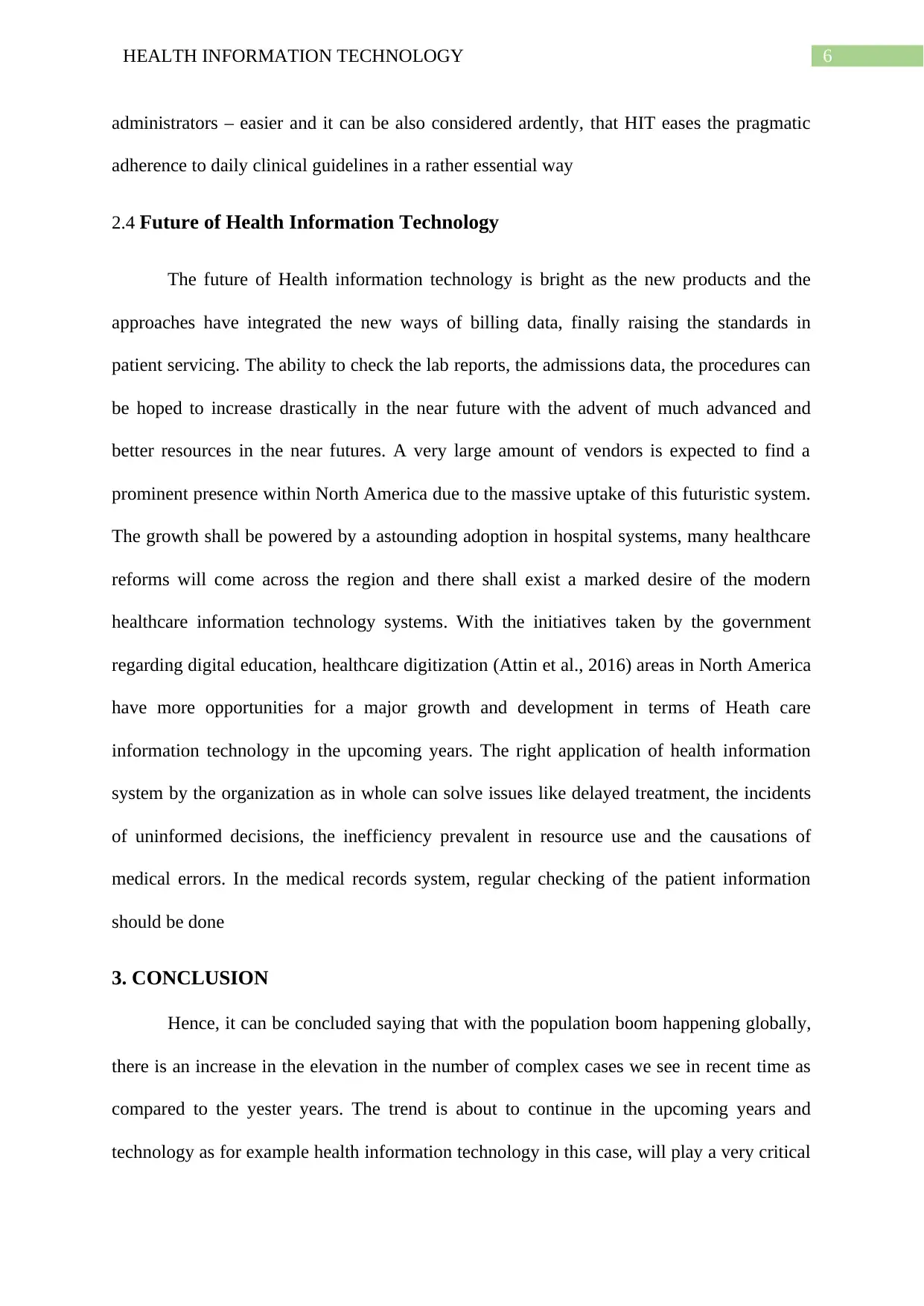
6HEALTH INFORMATION TECHNOLOGY
administrators – easier and it can be also considered ardently, that HIT eases the pragmatic
adherence to daily clinical guidelines in a rather essential way
2.4 Future of Health Information Technology
The future of Health information technology is bright as the new products and the
approaches have integrated the new ways of billing data, finally raising the standards in
patient servicing. The ability to check the lab reports, the admissions data, the procedures can
be hoped to increase drastically in the near future with the advent of much advanced and
better resources in the near futures. A very large amount of vendors is expected to find a
prominent presence within North America due to the massive uptake of this futuristic system.
The growth shall be powered by a astounding adoption in hospital systems, many healthcare
reforms will come across the region and there shall exist a marked desire of the modern
healthcare information technology systems. With the initiatives taken by the government
regarding digital education, healthcare digitization (Attin et al., 2016) areas in North America
have more opportunities for a major growth and development in terms of Heath care
information technology in the upcoming years. The right application of health information
system by the organization as in whole can solve issues like delayed treatment, the incidents
of uninformed decisions, the inefficiency prevalent in resource use and the causations of
medical errors. In the medical records system, regular checking of the patient information
should be done
3. CONCLUSION
Hence, it can be concluded saying that with the population boom happening globally,
there is an increase in the elevation in the number of complex cases we see in recent time as
compared to the yester years. The trend is about to continue in the upcoming years and
technology as for example health information technology in this case, will play a very critical
administrators – easier and it can be also considered ardently, that HIT eases the pragmatic
adherence to daily clinical guidelines in a rather essential way
2.4 Future of Health Information Technology
The future of Health information technology is bright as the new products and the
approaches have integrated the new ways of billing data, finally raising the standards in
patient servicing. The ability to check the lab reports, the admissions data, the procedures can
be hoped to increase drastically in the near future with the advent of much advanced and
better resources in the near futures. A very large amount of vendors is expected to find a
prominent presence within North America due to the massive uptake of this futuristic system.
The growth shall be powered by a astounding adoption in hospital systems, many healthcare
reforms will come across the region and there shall exist a marked desire of the modern
healthcare information technology systems. With the initiatives taken by the government
regarding digital education, healthcare digitization (Attin et al., 2016) areas in North America
have more opportunities for a major growth and development in terms of Heath care
information technology in the upcoming years. The right application of health information
system by the organization as in whole can solve issues like delayed treatment, the incidents
of uninformed decisions, the inefficiency prevalent in resource use and the causations of
medical errors. In the medical records system, regular checking of the patient information
should be done
3. CONCLUSION
Hence, it can be concluded saying that with the population boom happening globally,
there is an increase in the elevation in the number of complex cases we see in recent time as
compared to the yester years. The trend is about to continue in the upcoming years and
technology as for example health information technology in this case, will play a very critical
Paraphrase This Document
Need a fresh take? Get an instant paraphrase of this document with our AI Paraphraser
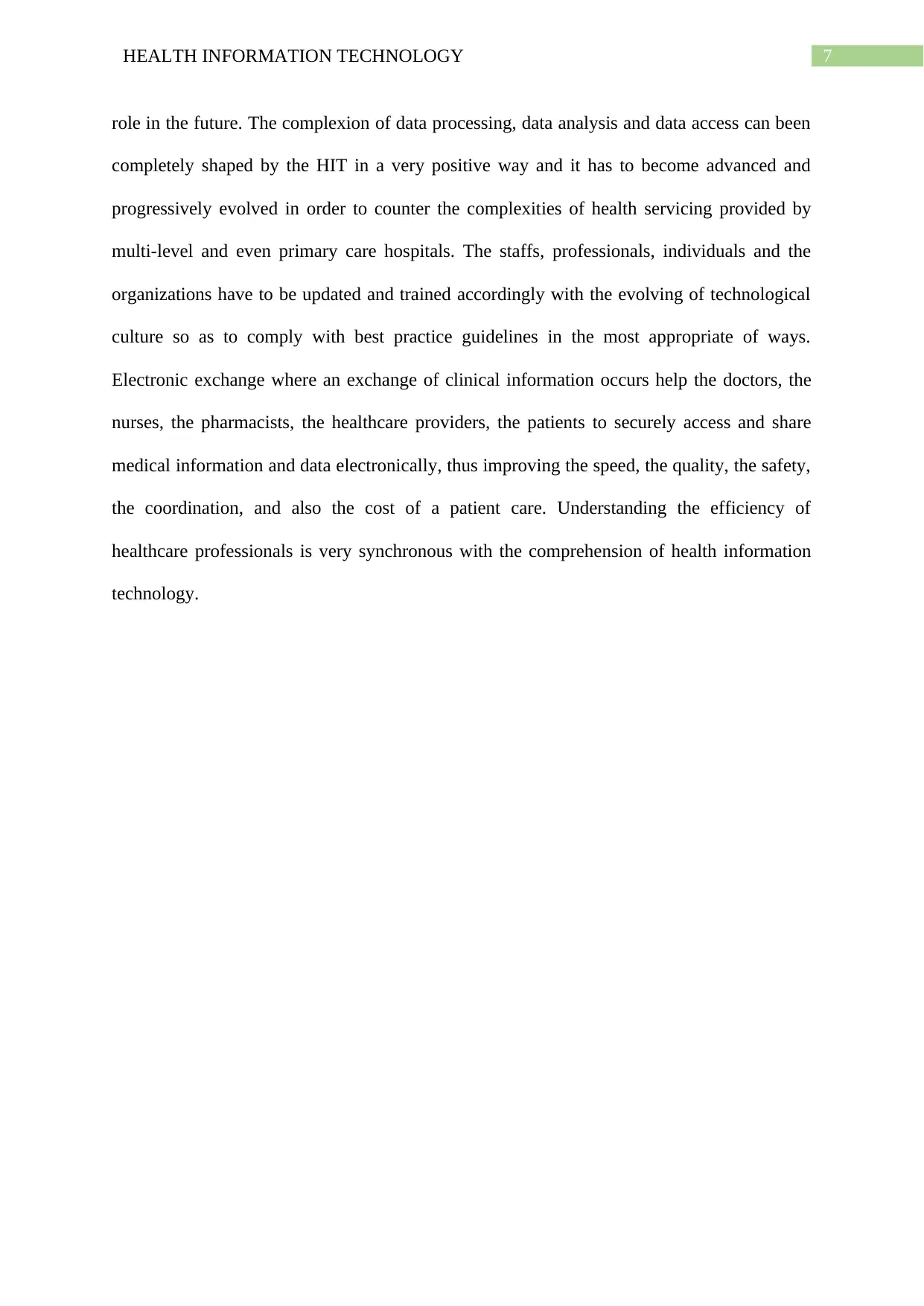
7HEALTH INFORMATION TECHNOLOGY
role in the future. The complexion of data processing, data analysis and data access can been
completely shaped by the HIT in a very positive way and it has to become advanced and
progressively evolved in order to counter the complexities of health servicing provided by
multi-level and even primary care hospitals. The staffs, professionals, individuals and the
organizations have to be updated and trained accordingly with the evolving of technological
culture so as to comply with best practice guidelines in the most appropriate of ways.
Electronic exchange where an exchange of clinical information occurs help the doctors, the
nurses, the pharmacists, the healthcare providers, the patients to securely access and share
medical information and data electronically, thus improving the speed, the quality, the safety,
the coordination, and also the cost of a patient care. Understanding the efficiency of
healthcare professionals is very synchronous with the comprehension of health information
technology.
role in the future. The complexion of data processing, data analysis and data access can been
completely shaped by the HIT in a very positive way and it has to become advanced and
progressively evolved in order to counter the complexities of health servicing provided by
multi-level and even primary care hospitals. The staffs, professionals, individuals and the
organizations have to be updated and trained accordingly with the evolving of technological
culture so as to comply with best practice guidelines in the most appropriate of ways.
Electronic exchange where an exchange of clinical information occurs help the doctors, the
nurses, the pharmacists, the healthcare providers, the patients to securely access and share
medical information and data electronically, thus improving the speed, the quality, the safety,
the coordination, and also the cost of a patient care. Understanding the efficiency of
healthcare professionals is very synchronous with the comprehension of health information
technology.
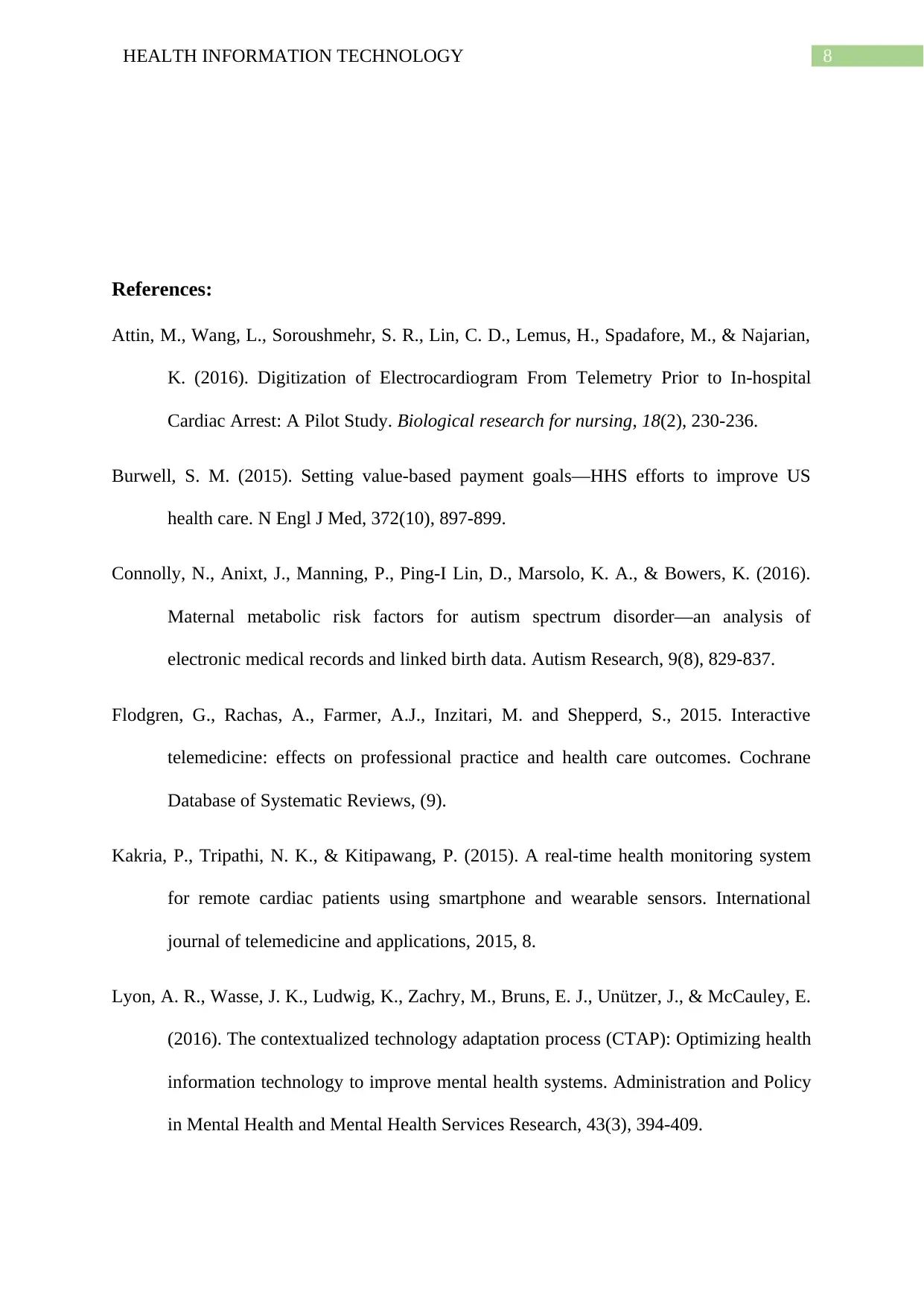
8HEALTH INFORMATION TECHNOLOGY
References:
Attin, M., Wang, L., Soroushmehr, S. R., Lin, C. D., Lemus, H., Spadafore, M., & Najarian,
K. (2016). Digitization of Electrocardiogram From Telemetry Prior to In-hospital
Cardiac Arrest: A Pilot Study. Biological research for nursing, 18(2), 230-236.
Burwell, S. M. (2015). Setting value-based payment goals—HHS efforts to improve US
health care. N Engl J Med, 372(10), 897-899.
Connolly, N., Anixt, J., Manning, P., Ping‐I Lin, D., Marsolo, K. A., & Bowers, K. (2016).
Maternal metabolic risk factors for autism spectrum disorder—an analysis of
electronic medical records and linked birth data. Autism Research, 9(8), 829-837.
Flodgren, G., Rachas, A., Farmer, A.J., Inzitari, M. and Shepperd, S., 2015. Interactive
telemedicine: effects on professional practice and health care outcomes. Cochrane
Database of Systematic Reviews, (9).
Kakria, P., Tripathi, N. K., & Kitipawang, P. (2015). A real-time health monitoring system
for remote cardiac patients using smartphone and wearable sensors. International
journal of telemedicine and applications, 2015, 8.
Lyon, A. R., Wasse, J. K., Ludwig, K., Zachry, M., Bruns, E. J., Unützer, J., & McCauley, E.
(2016). The contextualized technology adaptation process (CTAP): Optimizing health
information technology to improve mental health systems. Administration and Policy
in Mental Health and Mental Health Services Research, 43(3), 394-409.
References:
Attin, M., Wang, L., Soroushmehr, S. R., Lin, C. D., Lemus, H., Spadafore, M., & Najarian,
K. (2016). Digitization of Electrocardiogram From Telemetry Prior to In-hospital
Cardiac Arrest: A Pilot Study. Biological research for nursing, 18(2), 230-236.
Burwell, S. M. (2015). Setting value-based payment goals—HHS efforts to improve US
health care. N Engl J Med, 372(10), 897-899.
Connolly, N., Anixt, J., Manning, P., Ping‐I Lin, D., Marsolo, K. A., & Bowers, K. (2016).
Maternal metabolic risk factors for autism spectrum disorder—an analysis of
electronic medical records and linked birth data. Autism Research, 9(8), 829-837.
Flodgren, G., Rachas, A., Farmer, A.J., Inzitari, M. and Shepperd, S., 2015. Interactive
telemedicine: effects on professional practice and health care outcomes. Cochrane
Database of Systematic Reviews, (9).
Kakria, P., Tripathi, N. K., & Kitipawang, P. (2015). A real-time health monitoring system
for remote cardiac patients using smartphone and wearable sensors. International
journal of telemedicine and applications, 2015, 8.
Lyon, A. R., Wasse, J. K., Ludwig, K., Zachry, M., Bruns, E. J., Unützer, J., & McCauley, E.
(2016). The contextualized technology adaptation process (CTAP): Optimizing health
information technology to improve mental health systems. Administration and Policy
in Mental Health and Mental Health Services Research, 43(3), 394-409.
⊘ This is a preview!⊘
Do you want full access?
Subscribe today to unlock all pages.

Trusted by 1+ million students worldwide
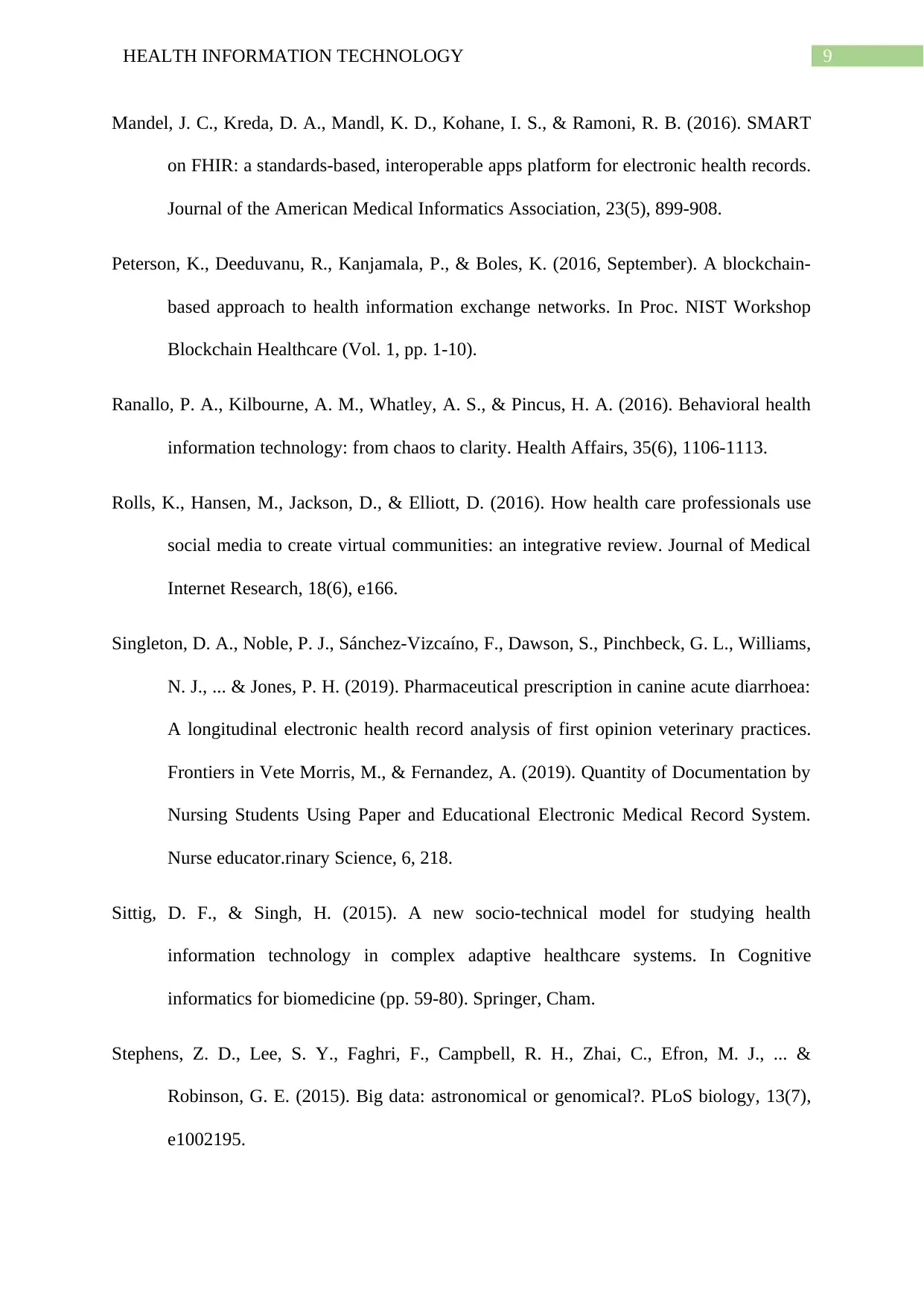
9HEALTH INFORMATION TECHNOLOGY
Mandel, J. C., Kreda, D. A., Mandl, K. D., Kohane, I. S., & Ramoni, R. B. (2016). SMART
on FHIR: a standards-based, interoperable apps platform for electronic health records.
Journal of the American Medical Informatics Association, 23(5), 899-908.
Peterson, K., Deeduvanu, R., Kanjamala, P., & Boles, K. (2016, September). A blockchain-
based approach to health information exchange networks. In Proc. NIST Workshop
Blockchain Healthcare (Vol. 1, pp. 1-10).
Ranallo, P. A., Kilbourne, A. M., Whatley, A. S., & Pincus, H. A. (2016). Behavioral health
information technology: from chaos to clarity. Health Affairs, 35(6), 1106-1113.
Rolls, K., Hansen, M., Jackson, D., & Elliott, D. (2016). How health care professionals use
social media to create virtual communities: an integrative review. Journal of Medical
Internet Research, 18(6), e166.
Singleton, D. A., Noble, P. J., Sánchez-Vizcaíno, F., Dawson, S., Pinchbeck, G. L., Williams,
N. J., ... & Jones, P. H. (2019). Pharmaceutical prescription in canine acute diarrhoea:
A longitudinal electronic health record analysis of first opinion veterinary practices.
Frontiers in Vete Morris, M., & Fernandez, A. (2019). Quantity of Documentation by
Nursing Students Using Paper and Educational Electronic Medical Record System.
Nurse educator.rinary Science, 6, 218.
Sittig, D. F., & Singh, H. (2015). A new socio-technical model for studying health
information technology in complex adaptive healthcare systems. In Cognitive
informatics for biomedicine (pp. 59-80). Springer, Cham.
Stephens, Z. D., Lee, S. Y., Faghri, F., Campbell, R. H., Zhai, C., Efron, M. J., ... &
Robinson, G. E. (2015). Big data: astronomical or genomical?. PLoS biology, 13(7),
e1002195.
Mandel, J. C., Kreda, D. A., Mandl, K. D., Kohane, I. S., & Ramoni, R. B. (2016). SMART
on FHIR: a standards-based, interoperable apps platform for electronic health records.
Journal of the American Medical Informatics Association, 23(5), 899-908.
Peterson, K., Deeduvanu, R., Kanjamala, P., & Boles, K. (2016, September). A blockchain-
based approach to health information exchange networks. In Proc. NIST Workshop
Blockchain Healthcare (Vol. 1, pp. 1-10).
Ranallo, P. A., Kilbourne, A. M., Whatley, A. S., & Pincus, H. A. (2016). Behavioral health
information technology: from chaos to clarity. Health Affairs, 35(6), 1106-1113.
Rolls, K., Hansen, M., Jackson, D., & Elliott, D. (2016). How health care professionals use
social media to create virtual communities: an integrative review. Journal of Medical
Internet Research, 18(6), e166.
Singleton, D. A., Noble, P. J., Sánchez-Vizcaíno, F., Dawson, S., Pinchbeck, G. L., Williams,
N. J., ... & Jones, P. H. (2019). Pharmaceutical prescription in canine acute diarrhoea:
A longitudinal electronic health record analysis of first opinion veterinary practices.
Frontiers in Vete Morris, M., & Fernandez, A. (2019). Quantity of Documentation by
Nursing Students Using Paper and Educational Electronic Medical Record System.
Nurse educator.rinary Science, 6, 218.
Sittig, D. F., & Singh, H. (2015). A new socio-technical model for studying health
information technology in complex adaptive healthcare systems. In Cognitive
informatics for biomedicine (pp. 59-80). Springer, Cham.
Stephens, Z. D., Lee, S. Y., Faghri, F., Campbell, R. H., Zhai, C., Efron, M. J., ... &
Robinson, G. E. (2015). Big data: astronomical or genomical?. PLoS biology, 13(7),
e1002195.
Paraphrase This Document
Need a fresh take? Get an instant paraphrase of this document with our AI Paraphraser
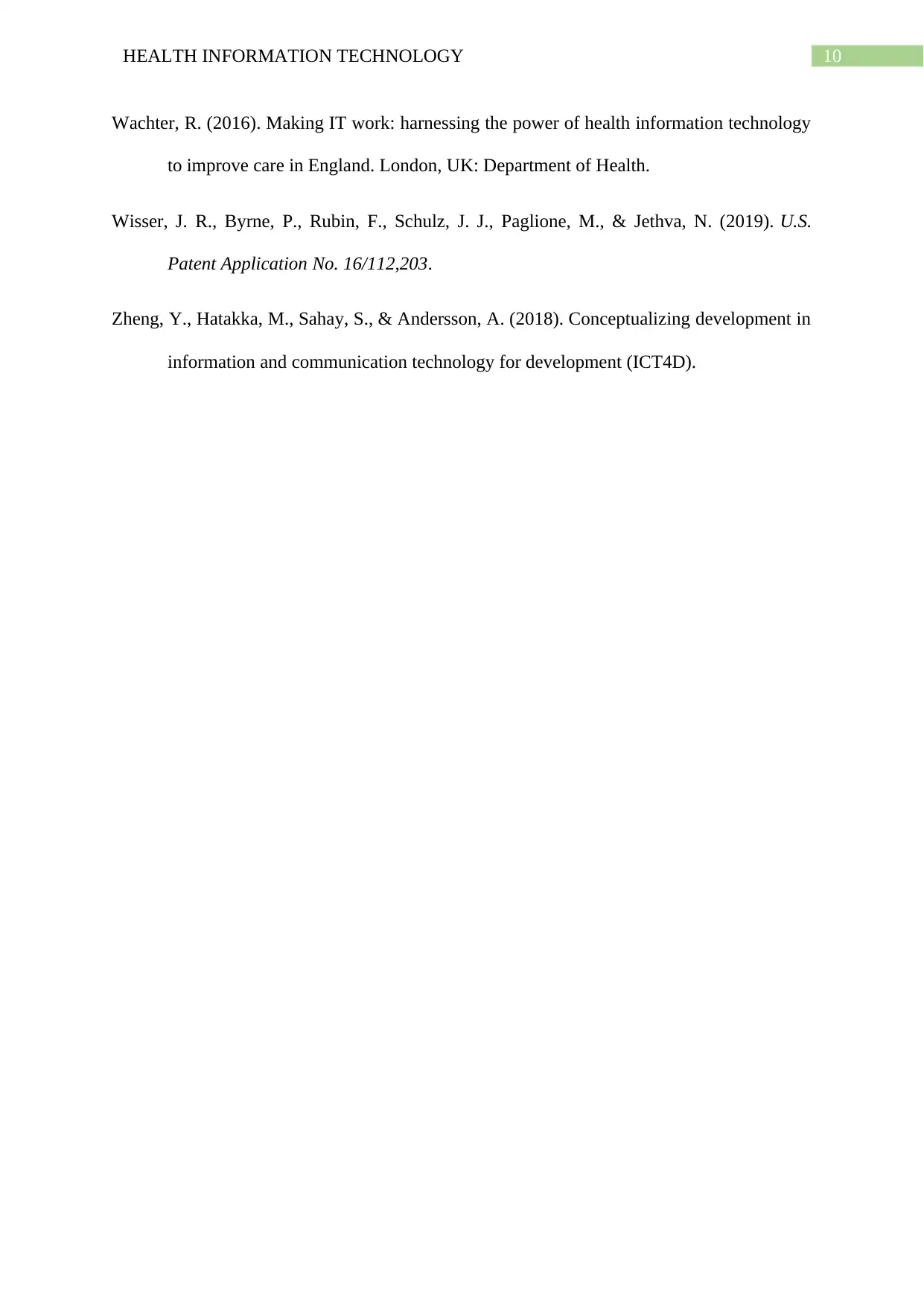
10HEALTH INFORMATION TECHNOLOGY
Wachter, R. (2016). Making IT work: harnessing the power of health information technology
to improve care in England. London, UK: Department of Health.
Wisser, J. R., Byrne, P., Rubin, F., Schulz, J. J., Paglione, M., & Jethva, N. (2019). U.S.
Patent Application No. 16/112,203.
Zheng, Y., Hatakka, M., Sahay, S., & Andersson, A. (2018). Conceptualizing development in
information and communication technology for development (ICT4D).
Wachter, R. (2016). Making IT work: harnessing the power of health information technology
to improve care in England. London, UK: Department of Health.
Wisser, J. R., Byrne, P., Rubin, F., Schulz, J. J., Paglione, M., & Jethva, N. (2019). U.S.
Patent Application No. 16/112,203.
Zheng, Y., Hatakka, M., Sahay, S., & Andersson, A. (2018). Conceptualizing development in
information and communication technology for development (ICT4D).
1 out of 11
Related Documents
Your All-in-One AI-Powered Toolkit for Academic Success.
+13062052269
info@desklib.com
Available 24*7 on WhatsApp / Email
![[object Object]](/_next/static/media/star-bottom.7253800d.svg)
Unlock your academic potential
Copyright © 2020–2025 A2Z Services. All Rights Reserved. Developed and managed by ZUCOL.





